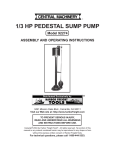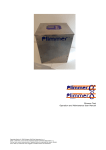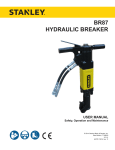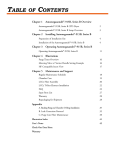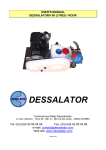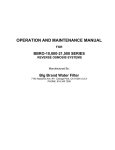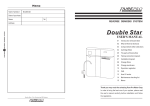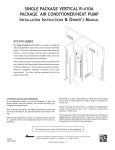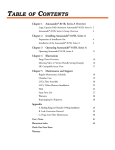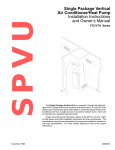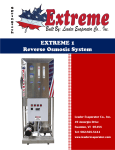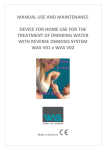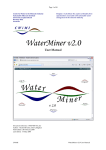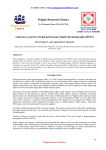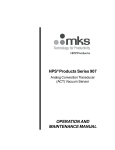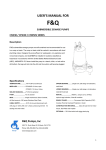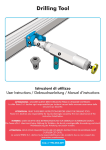Download Portable Electric Desalinator Operation Manual
Transcript
Portable Electric Desalinator Operation Manual Rainman Desalination www.rainmandesal.com Operation Manual v1.4e Table of Contents Getting to Know Your System 1 Pressure Supply Unit Reverse Osmosis Case Reverse Osmosis Single Membrane 1 2 3 How The System Works 4 Rainman System Concept System Schematic 5 6 Setting Up Your New System 7 Getting Started 7 Operating The Desalinator 9 Setting Up For Use Starting & Operating the System Desalinating While Under Way Desalinating Brackish Water Shutting Down Freshwater Flushing 9 13 16 18 20 21 Care and Maintenance 23 Reverse Osmosis Membrane Care Pickling Your Desalinator Pickling In Cold Climates Changing The Pre-filter High-Pressure Pump Maintenance Jabsco Lift Pump Service 23 25 26 27 28 29 Pressure Washing 30 Physical Storage 32 Service 33 Troubleshooting 34 Warranty 36 Getting to Know Your System Pressure Supply Unit 1 Reverse Osmosis Case 2 Reverse Osmosis Single Membrane 3 How The System Works The following two diagrams give an understanding of how your desalination system operates. 1. An impeller lift pump draws seawater up to the main unit and creates positive pressure for the high-pressure pump. 2. The pre-filter removes particulates larger than 5 microns from the water. 3. A piston pump pressurises the water 4. The relief valve opens if the control valve is closed excessively or a pressure washer gun is attached and idle. 5. A high-pressure hose carries filtered water to the reverse osmosis membranes. 6. Multiple RO membranes are connected in series (or a single RO membrane). 7. The manual control valve at the end of the system is used to set system pressure to approximately 55 bar (800psi). 8. Brine water is released to the sea while fresh water is routed to your drinking water tank. 4 Rainman System Concept 5 System Schematic 6 Setting Up Your New System Thank you for purchasing a Rainman portable desalination system. Please read this entire manual prior to using for the first time. Getting Started If your Rainman desalinator was delivered by freight and not picked up from a dealer, the pressure pump will have a leakfree travel oil plug fitted. You’ll need to swap it for an oil breather plug. 1. To swap the pressure pump plug, remove the pump cover from the Pressure Supply Unit. Remember the orientation of the cover as it only fits one way. 7 2. Remove the hex oil plug from the high-pressure pump and replace with the supplied breather plug. The breather plug has the world “OIL” on it. Save the travel plug in case the unit needs to be posted in the future. 3. The membranes inside the reverse osmosis unit are supplied immersed with a preservative (pickled). This preservative can cause gastro-intestinal upset if not flushed. The system will need to be run for at least 30 minutes before product water is consumed. 8 Operating The Desalinator This section explains how to operate the system on a regular basis, including set up, starting, stopping, and flushing the system. Setting Up For Use 1. Place the Rainman Pressure Supply Unit (PSU) and Reverse osmosis (RO) Unit in a stable place on the deck of your vessel. A swim platform is an ideal location. Make sure the PSU is no more than 2 metres (6 feet) above water level. The unit will work best operating as close to water level as possible. 9 Do not use on a swim platform if there is any chance of the unit getting wet. 2. Open the Reverse Osmosis (RO) Unit. Remove and uncoil the three hoses from the RO unit. Remove the white travel plug from the quick connect on the outside of the Pressure Supply Unit. Connect the black highpressure hose to the Pressure Supply Unit. 3. Remove the clear plastic spiral intake hose from the hose pocket on the Pressure Supply Unit and remove the cap. 10 Starting the unit with the cap in place will damage the pumps. 5. Place the intake hose in the source water. Make sure the intake hose is submerged and is not on the sea floor or among seaweed, which can cause blockage. 6. Direct the green brine hose overboard. 7. Place the white product water hose on the deck of your vessel. 11 Make sure the product water hose is NOT initially in your fresh water tank. 8. Ensuring the power switch is off, plug the power cord into an AC power source. If using a generator, make sure it is rated to at least 2000 Watts peak, 1600 Watts continuous power. Rainman does not recommend using battery power via an AC inverter as this could damage the battery bank. If using your watermaker in a foreign country, make sure the voltage and frequency match the unit. 9. Make sure the pressure valve in the reverse osmosis unit is in an open position (fully anti-clockwise). Never allow water containing chlorine to enter your desalinator. That includes town or tap water, which contains chlorine, or water from a vessel s tanks, which also may contain chlorine. Chlorine damages RO membranes. Never run the unit dry. You will damage the pumps. 12 Starting & Operating the System 1. Switch on the Pressure Supply Unit. 2. Water will start flowing out the green brine output water hose. Wait until the stream of water is free of bubbles. Upon first use, it may take up to 15 seconds to see water come out of the green hose. 3. Very gradually close the pressure control valve on the reverse osmosis unit by turning clockwise until the pressure gauge reads 55 bar (800 psi). The correct pressure is indicated by the green area on the pressure dial. For maximum membrane life, raise the pressure no more than 20 bar (300psi) a minute. Within 15 seconds water will start flowing out the white product hose. 13 Never exceed 58 bar (850 psi). If you over tighten the pressure control valve, a relief valve in the Pressure Supply Unit will release and water will recirculate within the unit. This prevents damage to the RO membranes from excess pressure. However, prolonged operation of the relief valve can damage the unit. If you are using your desalinator for the first time, run for at least half an hour to flush all preservatives from the system. 5. Every time you use the unit, let fresh water flow out the white product hose for approximately 60 seconds. You should test the product water at this point with a TDS meter or by taste. 14 6. When the product water is pure, put the product water hose in a fresh water tank and allow the system to run uninterrupted until full. Check the pressure gauge approximately every ten minutes and if necessary adjust the pressure if required to 55 Bar (800 psi). 7. Use the white 10 metre product water extension hose if necessary to fill multiple tanks without the need to move the desalination system. Note: Product water flow will vary depending on temperature and salinity. The warmer the water, the more fresh water will be produced. The higher the salinity, the less fresh water will be produced. For every degree Celsius increase in water temperature, product water flow increases approximately 3%. 15 Desalinating While Under Way Your Rainman desalinator can be operated while under way. The recommended method is to install a dedicated throughhull fitting in a position that will always be under water in all angles of heel. The Pressure Supply Unit will need to be placed securely and protected from getting wet. The green brine hose is then securely directed overboard. Some owners have reported success in using their watermaker while under way without a dedicated through hull by trailing the intake hose in the wash at the stern of their vessel. It is important to ensure the end of the hose is fully submerged in such a way that it doesn t create turbulence and suck air. 16 We recommend sliding the intake cap up the intake hose and securing it on board the vessel so that the end of the intake hose can sink sufficiently below the surface. We do not recommend using the detachable suction strainer when towing the intake hose. Success when making water while towing the intake hose depends on the hull shape and speed of the vessel. Some vessels will be unsuitable. When trailing the intake hose, the particle filter needs to be monitored closely for air bubbles. If the intake hose is sucking air, you will damage the membranes and this will not be covered by warranty. 17 Desalinating Brackish Water Brackish water is water that is less salty than seawater, but more salty than fresh water. Examples include estuaries, harbours and saline aquifers (bore water). After heavy rain, some sources of seawater can become less saline. The Rainman watermaker can be used to desalinate brackish water. A much lower pressure is needed, so when desalinating brackish water, only increase pressure until the rated fresh water production rate of your unit is achieved. The pressure can be as low as 200 PSI (13 bar). The rated fresh water production rate for the High Output Unit (twin 40 inch membranes) is 140 litres an hour (2.3 litres a minute). The rated fresh water production for the Compact RO Unit (twin 21 inch membrane) and the Economy RO Unit (single 40 inch membrane) is 70 litres an hour (1.15 litres per minute). 18 Never exceed the rated fresh water flow of your system. You will damage the membranes and this will not be covered by warranty. When desalinating any source other than ocean seawater, ensure the water is not contaminated with any substance that can damage the RO membranes and/or be toxic to humans. Some examples include oil (often found in harbours, estuaries and marinas), chlorine (found in town water and runoff from town water) and mineral deposits found in bore water. If in doubt, do not use your desalinator. 19 Shutting Down 1. To switch the unit off, first slowly turn the pressure control valve in an anti-clockwise direction until the pressure reads less than 300 psi (20 bar). 2. Switch off the Pressure Supply Unit. 3. Replace the cap on the intake hose to keep the unit primed during storage. 4. Replace the rubber boots on each of the other hoses to keep the system clean and prevent water dripping while stowed. Wait 60 seconds for internal pressure to dissipate before disconnecting the black high-pressure hose from the Pressure Supply Unit. For more information, please watch the instructional video at www.rainmandesal.com/support.html 20 Freshwater Flushing We recommend flushing your desalinator with fresh water after every use to prevent biological fouling and to rinse salt from the entire system. Freshwater flushing will prevent fouling for up to two weeks in temperate climates. 1. When the fresh water tank is full, remove the product water hose and fill an open container of water with approximately 10 litres (2.5 gallons) of fresh water. 21 2. Open the pressure control valve completely and switch off the unit. Remove the intake hose from the source water and place it in the open container of fresh water. Start the unit again, and with the pressure control valve remaining open, run the entire contents through the system. 3. When the bucket is almost empty, switch off your desalinator, leaving the fresh water in the system. Never allow the bucket to run dry while the pump is running. You will damage the unit. Never flush your desalinator with water containing chlorine, which will damage the membranes. That includes town or tap water, which contains chlorine, or water from a vessel s tanks, which also may contain chlorine. Chlorine damages RO membranes. If you plan on not using your watermaker within the next few weeks, you’ll need to pickle the membranes. 22 Care and Maintenance Your system is designed and built with high quality components. This section shows how to properly care for your system to ensure it lasts for many years. Reverse Osmosis Membrane Care The Dow Filmtec membrane or membranes in your Rainman desalinator should last between five and ten years if well cared for. The main way RO membranes are damaged is through biological growth or “fouling” on the surface of the membranes. This occurs if seawater is left sitting inside the RO pressure vessels for extended periods of time. In temperate climates, growth can occur in less than two weeks, in tropical climates, growth can occur in as little as a few days. There are no precise times in which fouling can occur, only rules of thumb. A conservative approach to membrane care will ensure long membrane life. Regular use of your desalinator is the most effective prevention against fouling. That means using your desalinator at least weekly in temperate climates and at least every few days in the tropics. 23 If unused for 2 days or less No pickling necessary If unused for between 2 and 7 Fresh water flush days If unused for between 7 and Pickle the system 30 days If unused for 30 days + Pickle the system, discard the pre-filter and drain the prefilter housing. Some pre-filters can turn black if stored too long in pickling solution. When storing the unit for more than a month, discard the pre-filter and drain the pre-filter housing. Some marine deposits can continue to decompose even when immersed in a pickling solution If you know you won’t be using your desalinator, you can flush the unit with fresh water to prevent fouling for a week or two in cool climates, less in warmer climates. If you won’t be using it for longer periods of time, the membranes can be preserved, or “pickled”, using a preservative solution. 24 Pickling Your Desalinator Pickling fills the membrane housings with a biocide that prevents fouling. Once pickled, membranes can be stored for six months or more. 1. To pickle your desalinator, add 5 tablespoons of Sodium Metabisulphite (SMBS) to a 10 litre (2.5 gallon) bucket of fresh water, to make a 1-1.5% solution of SMBS. After opening the pressure control valve completely, switch off the unit, remove the intake hose from the source water and place it in the open container of fresh water. Start the unit again, keeping the pressure control valve open and run the entire contents through the system. 2. When the bucket is almost empty, switch off your desalinator, leaving the pickling fluid in the system. When storing the unit for more than a month, discard the prefilter and drain the pre-filter housing. Your desalinator is now pickled and can be stored for up to 6 months. Never allow the pickling solution bucket to run dry while the pump is running. You will damage the unit. 25 Pickling In Cold Climates If there is a chance that your desalinator will be exposed to freezing temperatures, you’ll need to pickle the unit with Propylene Glycol, otherwise known as potable antifreeze. This will prevent damage to the unit through freezing, as well as preventing biological growth. 1. To pickle your desalinator with potable antifreeze, fill a bucket with ten litres (2.5 gallons) of Propylene Glycol. With the unit switched off, place the intake hose in the open container of potable antifreeze. 2. With the pressure control valve wide open, start the unit. Watch the brine output and switch the unit off when you see antifreeze coming out of it. Your unit is now protected from freezing and from biological growth for up to six months. 26 Changing The Pre-filter Pre-filters should be changed when they become visibly fouled. 1. To change the pre-filter, place the Pressure Supply Unit on the deck of your vessel. Use the supplied filter wrench to remove the clear filter housing. 2. Replace the filter and then fill the filter housing with water to aid the priming of the pump. 27 High-Pressure Pump Maintenance General Pump recommends the pump s crankcase oil be changed after an initial 50-hour break-in period. Oil should then be changed every 3 months or at 500-hour intervals thereafter. General Pump recommends their 100 Series oil, which is a SAE 30 weight (ISO 100), non-detergent oil. Crankcase oil can be drained by removing the brass plug on the underside of the high-pressure pump. To refill the crankcase oil, remove the orange breather plug on the top of the high-pressure pump. Insert a long stemmed funnel through the circular inspection port and add 350ml (12 ounces) of oil. 28 Oil levels can be checked through the hole to the right of the logo at the back of your watermaker. Jabsco Lift Pump Service The Jabsco lift pump can be accessed and serviced through the triangular port behind the pre-filter housing. 29 Pressure Washing By connecting the pressure washer gun (sold separately), the Rainman Desalinator becomes a powerful seawater pressure washer. Note: 115 volt units will require at least a 3kVA generator to use this feature. To Operate 1. Attach the pressure washer quick link hose to the Pressure Supply Unit. 2. Place the intake hose in the water. 3. Before starting, hold down the trigger on the pressure washer wand and at the same time, start the Pressure Supply Unit. The trigger must be depressed when you start the motor. 30 4. When the trigger is released, water will re-circulate inside the pump to release pressure. Do not allow the motor to run for more than 30 seconds with the trigger released as the water can heat up and damage the unit. 5. Be careful using the pressure washer on delicate surfaces. The pressure washer stream is powerful and can damage some surfaces including paint and wood. 6. If you use town or chlorinated water with your Rainman pressure washer, make sure you flush it completely before using the reverse osmosis unit. The chlorine in town water will damage the reverse osmosis membranes. 31 Physical Storage Your Rainman Pressure Supply Unit has an oil filled pump in it. In order to avoid oil draining from the pump, the system should not be inverted. Stow it securely in an upright position (below the deck of your yacht or in a locker if used in marine environment). Normal heeling of a yacht will not cause oil spillage. 32 Service If your desalinator exhibits any of the following problems, stop the unit immediately and consult a qualified technician. Unusual noises or vibration. The pressure gauge will not reach 55 bar (800 psi). With the unit running, there is no water flow through the green brine output water hose. The white product hose continues to make salty tasting water after several minutes at 55 bar (800 psi). Major leaks of water in the Pressure Supply Unit or the RO unit. 33 Troubleshooting • Symptom • Possible Cause • Solution • Pressure • Air in system • Check suction lines gauge will not for leaks reach 60 bar • Fouled inlet hose • Clean hose or • Fouled pre-filter(s) • Replace filter • The Pressure and/or the product amount drops cartridge • Cavitation (Noisy operation) • Airlocked pump • Check intake lines for restrictions • Allow more time to prime and ensure that there are no air suction leaks • Low fresh water flow • Damaged • Consult a qualified membranes • Insufficient pressure technician. • Make sure pressure gauge reads 55 bar (800 PSI) • Cold water temperature • Product water flow will decrease approximately 3% for each degree Celsius. 34 • Product water not fresh • Damaged • Replace RO membrane • Insufficient time from startup membrane • Allow your unit to run for up to half an hour, testing at regular intervals • Biological fouling in • Replace pre-filter pre-filter • Biological fouling in membrane • Product water flow rate higher than rated flow • Pressure set too high • Unit operating in • Damaged RO membrane vibration in high-pressure hose • Decrease pressure via valve brackish water • Excessive • Replace membrane • Cavitation due to blockage • Decrease pressure until rated fresh water flow is achieved • Replace membrane • Unblock intake hoses and pre-filter • Airlock inside highpressure pump • Open pressure control valve completely until air exits system completely. 35 Warranty Rainman desalinator Pressure Supply Unit and RO membrane units are guaranteed to be free of manufacturer defects and to perform within the published specifications for a period of one year from the date of shipment to the original purchaser. In the event of a warranty claim, Rainman Technology will inspect the defective component and repair or replace at our discretion. All shipping charges are the responsibility of the purchaser to and from our office in Sydney, Australia. The warranty is void if the system was mishandled, abused, or not operated / maintained as directed by this user manual. Consumable items, such as the pre-filter cartridge or engine lubricant are not covered under the terms of this warranty. Rainman Technology's liability under this warranty is limited to repair or replacement of our systems to the original purchaser. Under no circumstances is Rainman Technology Pty Ltd liable for consequential damages related to failure of the system to perform. 36








































